Guanajuato walking is different than walking in other cities–even cities known for being walking cities. New York is a walking city, in the sense that walking is part of life. You walk from your apartment to the train, from the train to work, and back again at the end of the day. Or Amsterdam, or Bruges. You can drive these cities, but it’s so much easier and more interesting to walk or bike over the cobblestone bridges that span the canals and deliver you into narrow alleys crammed with tiny shops and pubs.
As a city whose streets, walls, and oldest buildings date from the Spaniards’ arrival here in the 1540s, Guanajuato’s winding cobblestone alleys are reminiscent of those European cities whose major edifices were built around the same time. Unlike those European cities, in which driving is possible if inconvenient, many of Guanajuato’s major thoroughfares simply cannot be driven. Were not meant to be driven. Likewise, 80-90% of central Guanajuato’s residents literally cannot drive to their houses. Guanajuato walking is fundamental to Guanajuato living–walking is inseparable from your experience of this city.
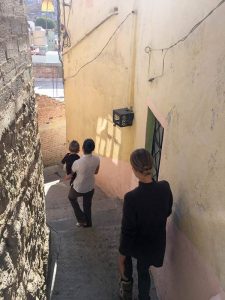 To understand why, you have to understand Guanajuato’s layout. Picture a rocks glass buried in the ground, three quarters surrounded by dirt up to the rim. The bottom of the glass is the small centro area of Guanajuato, while the sides of the glass, the bulk of its surface area, slope steeply up to the lip. This is Guanajuato. If you live here, your house is probably perched somewhere on the inside of the glass. Instead of wasting precious space with switchback roads, the slopes of Guanajuato are spiderwebbed by a byzantine circuit of narrow callejones, or alleys. Sometimes as wide as a one car road, other times nothing more than a stone staircase curving around a corner, the callejones are the real arteries of the city. Where the children have their pinatas strung up for birthday parties, where the water and gas vendors trek up and down making their distinct individual calls, where the teenagers play futbol at night. Though you can’t get up the callejones with a car, and though you have at least a 300 yard uphill walk to your house no matter where you’re coming from, it does mean that panoramic views are not reserved for the rich.
To understand why, you have to understand Guanajuato’s layout. Picture a rocks glass buried in the ground, three quarters surrounded by dirt up to the rim. The bottom of the glass is the small centro area of Guanajuato, while the sides of the glass, the bulk of its surface area, slope steeply up to the lip. This is Guanajuato. If you live here, your house is probably perched somewhere on the inside of the glass. Instead of wasting precious space with switchback roads, the slopes of Guanajuato are spiderwebbed by a byzantine circuit of narrow callejones, or alleys. Sometimes as wide as a one car road, other times nothing more than a stone staircase curving around a corner, the callejones are the real arteries of the city. Where the children have their pinatas strung up for birthday parties, where the water and gas vendors trek up and down making their distinct individual calls, where the teenagers play futbol at night. Though you can’t get up the callejones with a car, and though you have at least a 300 yard uphill walk to your house no matter where you’re coming from, it does mean that panoramic views are not reserved for the rich.
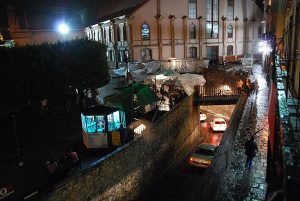
Cars aren’t accommodated at the bottom of the glass, either, but shunted into the earth via tunnels. Though the Guanajuato tunnels help to divert traffic, they were originally built to divert the Guanajuato River and its seasonal flooding away from the heart of the city. As you tour Guanajuato walking, admiring the churches and basilicas of green and pink sandstone and listening to the chatter of a city full of walkers, you see the occasional stream of cars appearing briefly here and there, like ants from their warrens who quickly dip back down into the earth.
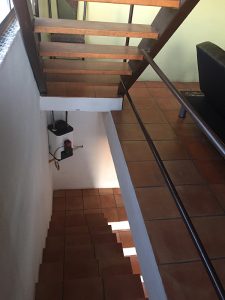 I’ve not yet worked up the courage to conduct a visual survey, but I bet if you checked out the butts and thighs of Guanajuato residents, you’d want to cast them all in plaster and put them in your garden. Gym membership? Waste of money! We live in a gym. In the morning, we traverse the callejones across the mountain to drop Spencer off at preschool, then I make my way down to the panadería (baker), carnicería (butcher), and fruitería (fruit and vegetable store), for our daily groceries, walking back up with my bags can be intense, and then I get a day of endurance training as I go from my kitchen on the ground floor to my bedroom on the second floor, to the living room on the third floor, up to the roof to do laundry and water plants, and back down and up again countless times during the day. Guanajuato walking and stair-stepping is unavoidable: young or old, rich or poor.
I’ve not yet worked up the courage to conduct a visual survey, but I bet if you checked out the butts and thighs of Guanajuato residents, you’d want to cast them all in plaster and put them in your garden. Gym membership? Waste of money! We live in a gym. In the morning, we traverse the callejones across the mountain to drop Spencer off at preschool, then I make my way down to the panadería (baker), carnicería (butcher), and fruitería (fruit and vegetable store), for our daily groceries, walking back up with my bags can be intense, and then I get a day of endurance training as I go from my kitchen on the ground floor to my bedroom on the second floor, to the living room on the third floor, up to the roof to do laundry and water plants, and back down and up again countless times during the day. Guanajuato walking and stair-stepping is unavoidable: young or old, rich or poor.
Though central Guanajuato bustles with tourists who come from all over to see the Don Quixote Museum, Las Momias, and the picturesque city itself, it feels like more of a working and middle class university town than a tourist town. The University of Guanajuato was established in 1732 and now hosts over 30,000 students. A few minutes’ walk outside of the busiest streets and university buildings, you’ll find yourself in a neighborhood with a choice of two or three butchers, fruit/veg stores, bakeries, and dairies within a five minute walk. In the early morning, the pink streets are peopled by the smartly dressed professors, real estate agents, lawyers, and other middle class residents on their way to work, along with the students, and working class mothers and fathers walking their uniformed children to one of the many federal schools which are frequently preschool/primary/secondary combos.
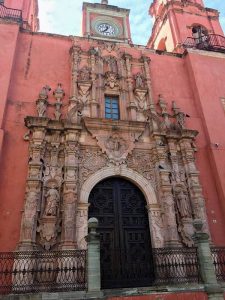 By mid-morning, the street commerce is up and running. Depending on where you live, you might visit the Hidalgo or Embajadoras markets, where you can buy anything from kitchen and houseware supplies, to new or used clothing, herbs and flowers, fresh fruit juice or coconut pieces or chicharron, to fruits and vegetables for cooking, fish, candy, you name it. This morning when I stopped into the bakery, everyone was buying an assortment of fresh, preservative-free baked treats for their colleagues and families on Valentines Day. Of course, for lunch you have your choice of taco and ceviche tostada vendors, as well as homemade ice cream stands and chicharrones, fried pork skin. When we worked through Spencer’s list of school materials this weekend, we really tested the limits of this small, locally owned economy. Despite a wide-ranging list of about twenty items, we found 18 of them from about ten different vendors, all within a 500 yard radius. Of course, even in such a small space, it involved a lot of Guanajuato walking.
By mid-morning, the street commerce is up and running. Depending on where you live, you might visit the Hidalgo or Embajadoras markets, where you can buy anything from kitchen and houseware supplies, to new or used clothing, herbs and flowers, fresh fruit juice or coconut pieces or chicharron, to fruits and vegetables for cooking, fish, candy, you name it. This morning when I stopped into the bakery, everyone was buying an assortment of fresh, preservative-free baked treats for their colleagues and families on Valentines Day. Of course, for lunch you have your choice of taco and ceviche tostada vendors, as well as homemade ice cream stands and chicharrones, fried pork skin. When we worked through Spencer’s list of school materials this weekend, we really tested the limits of this small, locally owned economy. Despite a wide-ranging list of about twenty items, we found 18 of them from about ten different vendors, all within a 500 yard radius. Of course, even in such a small space, it involved a lot of Guanajuato walking.
Read our upcoming post to find out what it was like to get Spencer into a school, and more about this beautiful city.
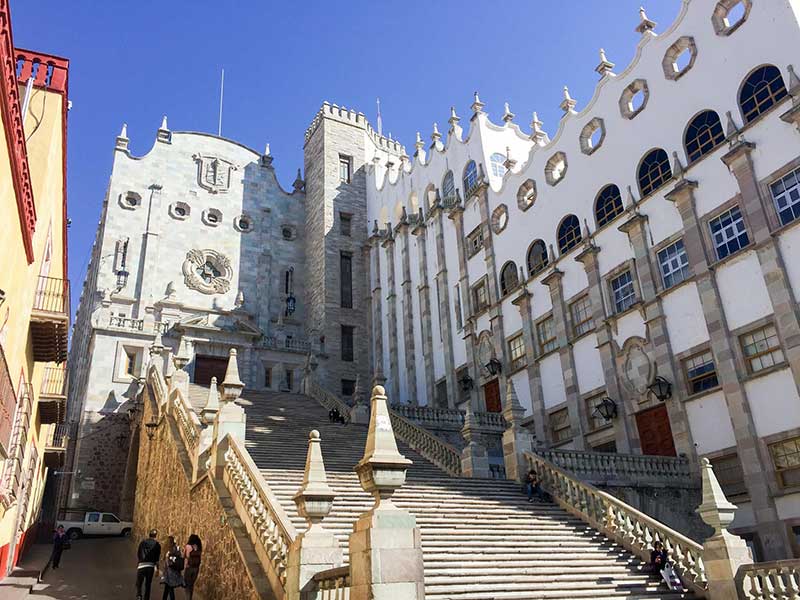
Leave a Reply